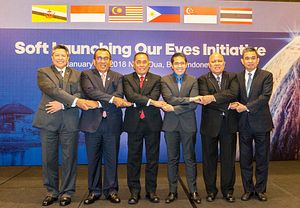Late last month, Southeast Asian states held a working group meeting to discuss the status of a new intelligence-sharing initiative to help them respond more quickly and effectively to transnational security threats. The meeting spotlighted the effort amid the broader context of regional responses to terrorism and radicalism in Southeast Asia and the Asia-Pacific more generally.
As I have noted before in these pages, terrorism fears in Southeast Asia – made clear through attacks in several Southeast Asian countries, with the most recent being the bombing of a cathedral in the southern Philippines late last month – have led states to take a range of steps on their own as well as bilaterally, regionally, and subregionally.
One of the less well-known steps is what has come to be known as the “Our Eyes” initiative (OEI). The OEI, which derives its name from the “Five Eyes” intelligence network that the United States has with its five Western allies, was initially officially proposed by Indonesia, with the idea being an information-sharing platform for member countries designed to facilitate the exchange of intelligence on terrorism, radicalism, and violent extremism.
While OEI was initially talked about as an initiative between Indonesia, Malaysia, and the Philippines (or “three eyes”) in line with wider trilateral cooperation, it was subsequently discussed as part of broader multilateral discussions, including in the first joint working group meeting between countries. Through 2018, there have been follow up discussions as well about specifics, including the agencies involved and areas covered.
Last month, the initiative was in the headlines again with the holding of the second working group meeting in Indonesia. The two-day ASEAN Our Eyes Working Group meeting was held as scheduled in Semarang, Central Java, and it was attended by delegates from the 10 ASEAN states as well as representatives from the ASEAN Secretariat.
According to the Indonesian defense ministry, the meeting saw the delegations present their perspectives on the initiative and some additional discussion about how exactly to operationalize it. With the multilateralization of this intelligence-sharing platform as an ASEAN-wide mechanism, there was also an agreement to rename it the ASEAN Our Eyes Initiative (AOEI).
How exactly OEI/AOEI moves forward now remains unclear. While there was some discussion about operationalization, we still have not publicly gotten a sense of exactly what the standard operating procedures (SOPs) are like, and which exact communication channels will be used. There has been mention of using the ASEAN Direct Communications Infrastructure – a secured hotline for defense ministers officially launched back in 2017 – but given that this is quite a new mechanism, we will need to know much more in terms of specifics to understand what this means for how OEI will progress.
Beyond this, as I have observed before, there are also significant challenges remaining in intelligence-sharing across countries in Southeast Asia. Many of these are tied to deep-seated issues, from lingering interstate distrust to differences in organizational culture to bureaucratic rivalries within the agencies of individual countries. These issues had made it difficult to operationalize OEI between the initial three countries, and they will in some ways be compounded as this is expanded across all ASEAN members, and possibly beyond those to include dialogue partners as well. That is worth keeping in mind as we see this initiative continue to develop through 2019 as well.

































